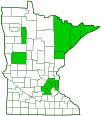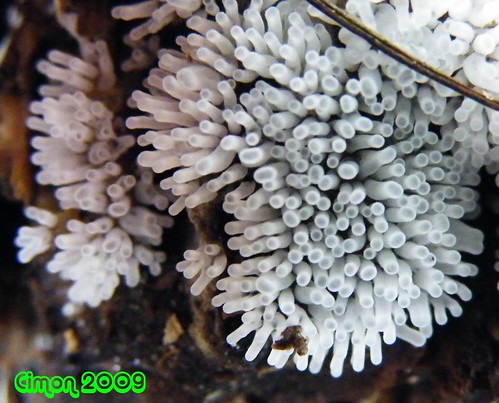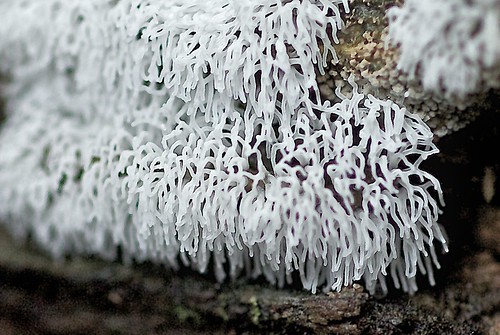honeycomb coral slime mold
(Ceratiomyxa fruticulosa)
Conservation • Description • Habitat • Ecology • Distribution • Taxonomy
|
|
||||||||||||||
Description |
Protostelid slime molds are relatively unknown and easily overlooked. They were first recognized in the early 1960s and have been little studied since. There are 36 currently accepted species, and possibly twice that number of undescribed species. Most are microscopic. Only a few are visible to the naked eye. Honeycomb coral slime mold, also called simply coral slime, is the most commonly encountered protostelid slime mold and may be the most common slime mold of any kind in the world. It occurs on every continent except Greenland and Antarctica. In the United States it is common east of the Great Plains, including Minnesota, and west of the Rocky Mountains. It is absent in the arid west. It is found on shaded rotting wood of fallen logs and branches, in open, wet to moderately moist deciduous, coniferous, and mixed forests. It does not feed on the wood but on bacteria associated with the rotting wood. It can form extensive colonies one meter or more long. It is very short lived, appearing after a soaking rain and disintegrating in just a few days. Honeycomb coral slime mold first appears as a thin, watery, translucent, mucus-like layer of protoplasm (plasmodium). It creeps across the substrate, engulfing bacteria, protozoa, and particles of nonliving organic matter. Eventually, the plasmodium fruits, converting to spore-bearing structures (sporocarps). The conversion takes about six hours. The sporocarps are erect, slender, translucent columns appearing usually in clusters of three or more. The clusters often form patches 4″ or more in diameter. The columns are 1 ⁄32″ to ⅜″ (1 to 10 mm) long, 1 ⁄64″ to 3 ⁄64″ (0.5 to 1.0 mm) in diameter, and tapered. They may be branched or unbranched. When they first appear they are slimy, translucent, and usually white, rarely pink or yellow. Later, they have a frosted or powdery appearance due to a dense covering of tiny, white, spores on long, thread-like stalks. The spores may actually be one-celled sporangia. It is not edible. |
Similar Species |
No similar species in Minnesota |
Habitat and Hosts |
Open, wet to moderately moist, deciduous, coniferous, and mixed forests |
Ecology |
Season |
June through October |
Distribution |
||
|
Sources Biodiversity occurrence data published by: Minnesota Biodiversity Atlas (accessed through the Minnesota Biodiversity Atlas Portal, bellatlas.umn.edu, 6/23/2025). |
|
| 6/23/2025 | ||
Occurrence |
||
Common and widespread |
||
Taxonomy |
|
Kingdom |
Protozoa (protozoans) |
Phylum |
Mycetozoa (slime molds) |
Class |
Ceratiomyxomycetes |
Order |
Ceratiomyxales |
Family |
Ceratiomyxaceae |
Genus |
Ceratiomyxa (coral slimes) |
Higher ranking |
|
Subordinate Taxa |
|
honeycomb coral slime mold (Ceratiomyxa fruticulosa f. flava) honeycomb coral slime mold (Ceratiomyxa fruticulosa f. rosea) honeycomb coral slime mold (Ceratiomyxa fruticulosa var. arbuscula) honeycomb coral slime mold (Ceratiomyxa fruticulosa var. aurantiaca) honeycomb coral slime mold (Ceratiomyxa fruticulosa var. comata) honeycomb coral slime mold (Ceratiomyxa fruticulosa var. descendens) honeycomb coral slime mold (Ceratiomyxa fruticulosa var. flexuosa) honeycomb coral slime mold (Ceratiomyxa fruticulosa var. fruticulosa) |
|
Synonyms |
|
Byssus fruticulosa Ceratiomyxa mucida Ceratium hydnoides Ceratium porioides Clavaria byssoides Clavaria puccinia Flora carniolica Isaria mucida Tremella hydnoidea |
|
Common Names |
|
common coral slime coral slime coral slime mold honeycomb coral slime mold icicle fairy fans (Australia) white coral slime |
|
Glossary
Sporangium
A spore bearing structure, as of a fern, moss, or slime mold. Plural: sporangia.
Visitor Photos |
||
Share your photo of this slime mold. |
||
This button not working for you? |
||
Greg Watson |
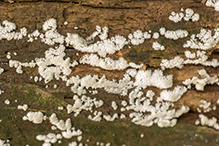 |
Paul |
||
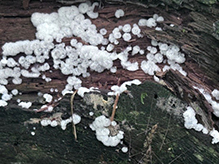 |
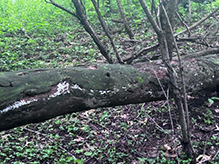 |
|
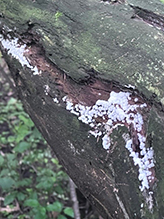 |
||
Alfredo Colon |
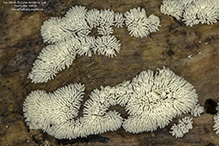 |
MinnesotaSeasons.com Photos |
||
|

Visitor Videos |
||
Share your video of this slime mold. |
||
This button not working for you? |
||
|
Other Videos |
||
Ceratiomyxa fruticulosa sporangia development |
About
Published on Oct 17, 2010 Time lapse video of the slime mold Ceratiomyxa fruticulosa var. poroides developing sporangia. Original time approx. 24 h |
Ceratiomyxa fruticulosa (O.F. Müll.) T. Macbr. 1899 |
About
Published on Jun 5, 2018 Ceratiomyxa fruticulosa Lekeitio, Bizkaia M.merino Hábitat: madera de pino en descomposición |
Ceratiomyxa fruticulosa, the coral slime mold |
About
Published on May 28, 2011 Not actual a fungus but a protist, this beautiful slime mold was found in South Woods Park, Shoreline, WA, USA, 5/28/11 |

Visitor Sightings |
||
Report a sighting of this slime mold. |
||
This button not working for you? |
||
| Greg Watson 6/22/2025 |
Location: Magelssen Bluff Park |
 |
| Alfredo Colon 7/29/2018 |
Location: Woodbury, Minnesota |
 |
MinnesotaSeasons.com Sightings |
||
|

Created: 1/30/2019 Last Updated: © MinnesotaSeasons.com. All rights reserved. |
